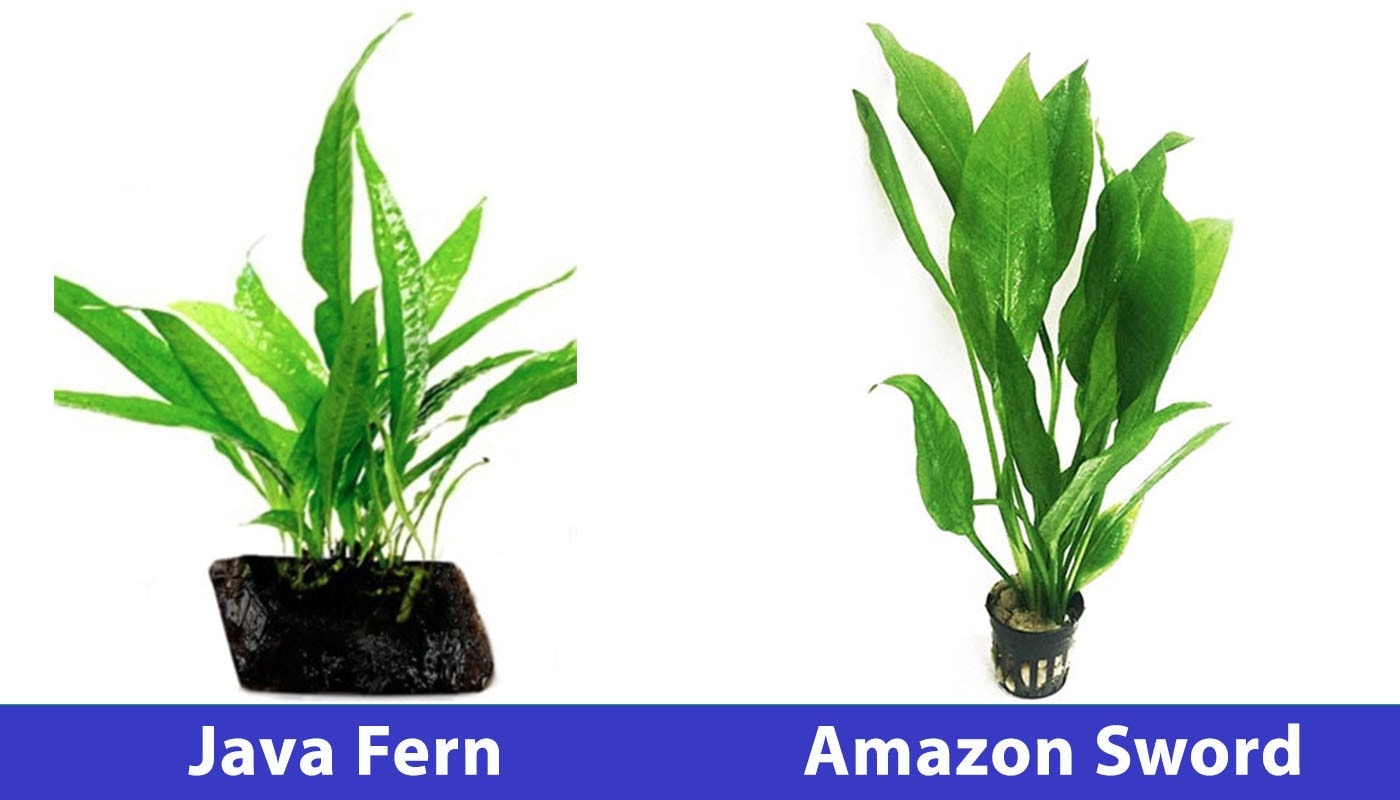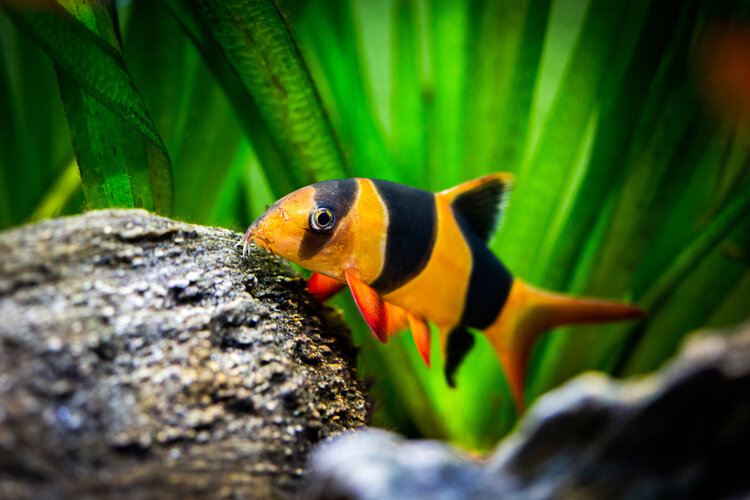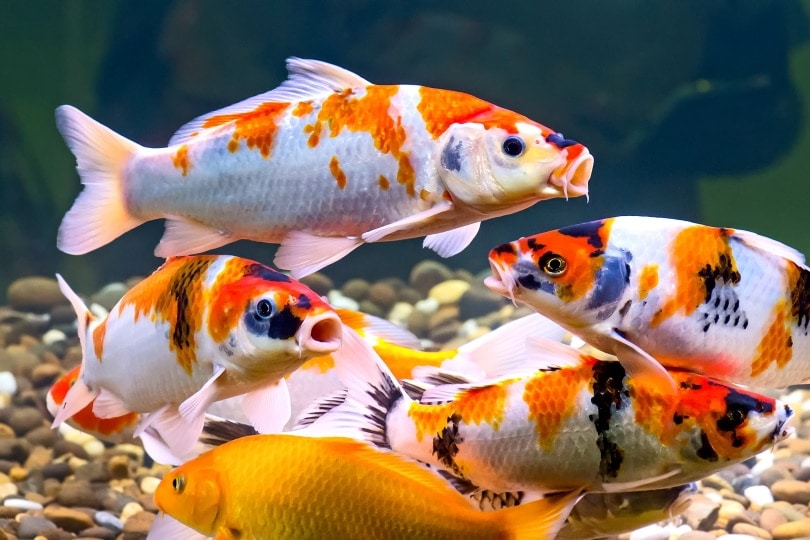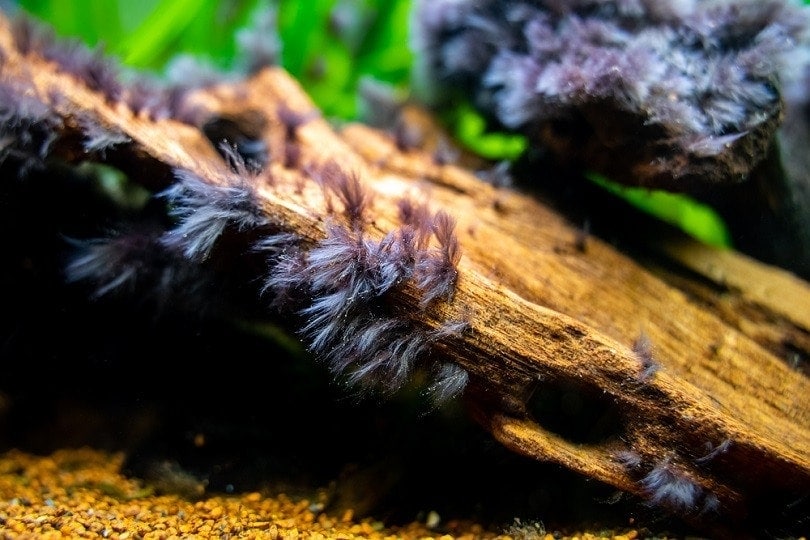Java Fern vs Amazon Sword: What are the Differences?

Updated on
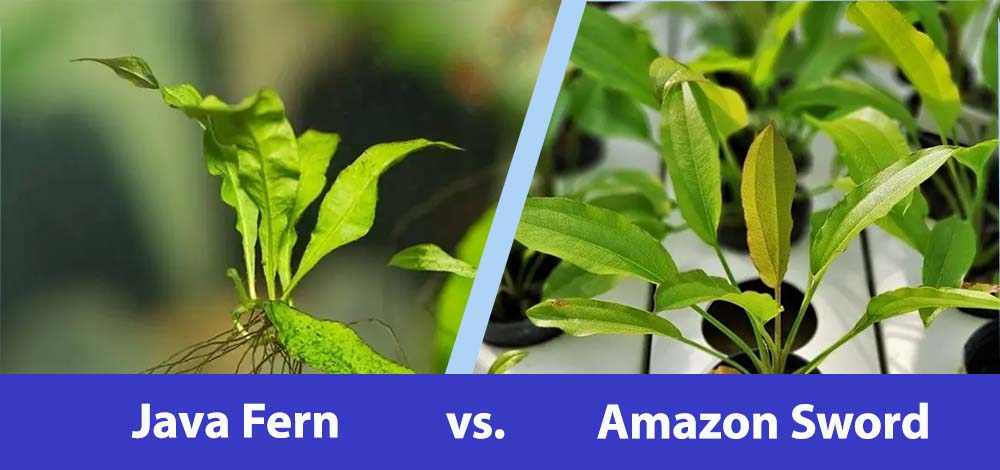
Do you have an aquarium, or are looking to set one up, but don’t know what kind of plants you want to add? Well, Java ferns and Amazon swords are both great choices to go with.
However, when it comes to the Java fern vs Amazon sword, if you could only choose one, which would it be? Let’s talk about each of them in some greater detail so you know exactly what to expect.
- Color: Green
- Width: 8 inches
- Height: 12 inches
- Care: Easy
- Ideal pH: 6.0–7.0
- Ideal temp: 68–92 Fahrenheit
- Color: Green
- Width: 6 inches
- Height: 24 inches
- Care: Easy
- Ideal pH: 6.5–7.5
- Ideal temp: 72–82 Fahrenheit

Java Fern
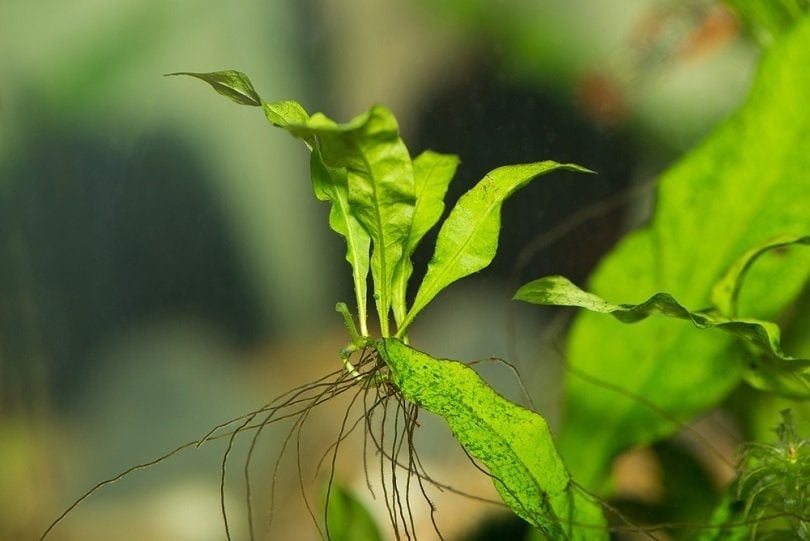
The Java fern is a jungle plant from Southeast Asia that usually grows on rocks, on the ground, around tree trunks, and by the waterline of waterfalls and other bodies of water.
What is neat about the Java fern is that it can grow fully on the ground and it can grow fully submerged as well. There are actually quite a few different kinds of this plant, with three or four of them being very popular for home aquariums.
It’s a really hard plant that is nearly impossible to kill, and it does not cost much to purchase either.
Appearance
The Java fern has two main components, the rhizome and the leaves. The rhizomes are the anchors of the Java fern, and they are these thin brown strings that can attach themselves to nearly anything.
This is a green plant, one that is generally used in aquariums, and it can come in a variety of shades of green. If there is more lighting, the green should be darker. The leaves of the Java fern are quite thick and hardy, somewhat leathery in texture as well. What is interesting about the Java fern is that it comes in many different shapes, with some of them having spiky leaves and some looking a bit bushier. Some of the leaves may develop dark bumps or even blackish veins running along them.
Generally speaking, this plant will grow to a little over 1 foot in height and roughly 8 inches in width, making it a good size for many tanks. There are four main kinds of this plant that you might have in your aquarium. These include the narrow leaf Java fern, the needle leaf Java fern, the trident Java fern, and the Windelov Java fern.
Tank Requirements

As we mentioned before, the Java fern is actually quite easy to care for, but if you really want it to flourish, you do need to provide it with the right tank conditions. In the wild, these plants are often near moving water, as it helps to supply them with nutrients, oxygen, and CO2, so you do want to have it near a filter or power head to provide it with a bit of water movement, but not too much.
To make sure that this plant thrives, it should be in water that has a hardness level between 3 and 8 dGH, with a pH or acidity level ranging from 6.0 to 7.0. It is a really convenient plant to have in an aquarium because it does not need very much light or high lighting, you don’t really have to give it nutrients, and it can survive in a variety of conditions.
However, with that said, it will do better if you give it an adequate amount of light and a decent amount of nutrients. In fact, if the lighting is too strong, the leaves may start to become transparent and even die.
It’s also a very easy-to-care-for plant as it does not require substrate. It is the perfect plant to have if you have a bare bottom tank without substrate, but if you want it to develop a very strong root system, you will want to use some aquarium gravel. Keep in mind that the ideal water temperature for the Java fern is between 68 and 82 degrees Fahrenheit.
Planting & Care
What’s also nice about the Java fern is that you do not have to do much in the way of planting. As we mentioned before, it does fine in bare-bottom tanks, and it has no problem growing on rocks or wood. In fact, if the rhizomes, or in other words, the roots are buried, they may not grow at all.
They like rough surfaces such as driftwood. Simply use some fishing line to tie them down until they are able to stand in place on their own. You can remove the ties once the roots are secured well enough. This is more of a background plant, as the leaves can grow fairly wide, and they may obscure everything else in the tank.
As we mentioned before, this plant really does not require much special care. Yes, you can add CO2 to the water, as well as some nutrients, and get it a killer light too, but it really is not necessary. As long as you maintain the water parameters that we discussed above, you should not have any problems.
Propagation
Propagating the Java Fern is about as easy as can be. You can simply cut the rhizomes in half and plant each half separately, as both will continue to grow into full plants.
Sometimes the Java fern will also develop new little Java Ferns on its leaves, which can be cut off after about 3 weeks after they start to grow, which can then also be planted.
Tank Mates
Another bonus of the Java fern is that it is highly compatible with pretty much any type of fish out there. Even herbivorous fish that would usually eat aquarium plants won’t eat this one.
Apparently, it does not taste very good to most fish. Just beware that if the root system is not yet well-developed, it is susceptible to being knocked over by rough and playful fish.
Amazon Sword
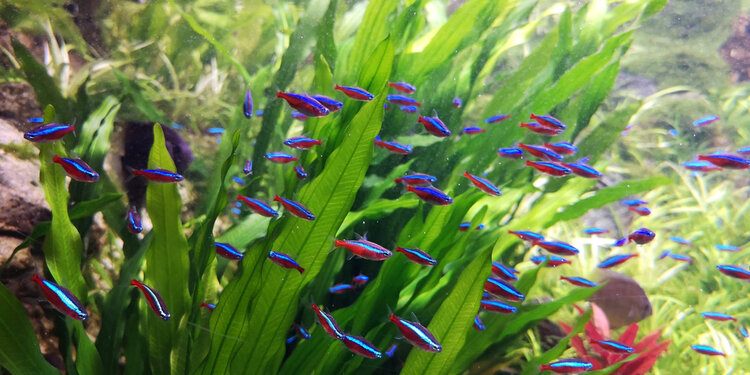
This is a very common and popular aquarium plant that can be found in virtually every single pet store that sells fish. There are ones with broad leaves and ones with narrow leaves, but they are more or less the same plant.
As you might have guessed, this plant does come from the Amazon rainforest, where it grows along the sides of the Amazon river, slower moving parts of it, as well as along streams and other places where there is a bit of moving water. Just like the Java fern, the Amazon sword is very hardy, resilient, and easy to care for.
Appearance
The Amazon sword is a fairly large plant. At the bottom, you will see a fairly thick root system comprised of white and brown hair-like strings, although a bit thicker than hairs. They have long, round, and fairly bright green stems. Now, this is not like a bush in the sense that it has multiple leaves or bulbs per stem. In fact, each leaf has its own green, round stem.
The leaves here are the masterpiece, as they can grow up to 24 inches long (high) apiece, and can be several inches wide as well, up to 5 or 6 inches in width. As you may have noticed, it can grow to close to twice the size of the Java fern.
For this reason, most people who have an Amazon sword in their aquarium choose to use it as a background plant, because if put in the front or center, it will block your view of mostly everything else. Also, keep in mind that because these plants grow fairly fast and very tall, they don’t do too well in a small tank, such as a nano tank.
Tank Requirements
Just like the Java fern, the Amazon sword is fairly hardy, resilient, and easy to care for. Sure, if you want it to grow big and strong, you can supplement it with CO2, strong lighting, and lots of nutrients, but it really is not necessary.
This thing will grow in most conditions as long as they are not too extreme. As we will elaborate on below, Amazon swords do need a tank with a substrate for their root systems, something like aquarium gravel or aquarium planting soil will do just fine. They won’t be able to grow in a bare-bottom tank like the Java fern.
When it comes to water temperature, the same temperature as your tropical fish will do just fine, so between 72 and 82 degrees Fahrenheit. The ideal pH level for this plant is between 6.5 and 7.5, although they will usually be able to survive in pH levels as low as 6.0.
In terms of water hardness, between 3 and 8 dGH is fine. Now, one thing to note about the Amazon sword is that it does need a lot of light. You want to provide it with moderate to strong lighting for 9 to 12 hours per day. The stronger the light is, the less time you have to provide it.
Planting & Care
Planting the Amazon sword is quite easy, although you do want to have some nutrient-rich substrate, such as aquarium soil, but aquarium gravel will do fine too. Simply plant the root systems in the gravel or dirt, making sure to pack it down a bit once planted, but you don’t want to pack it down too hard, or else you will compact the roots to the point where they can no longer absorb nutrients.
You want to have around 2 inches of substrate, as the Amazon sword has a big root system, and it needs those big roots to support those big leaves.
There’s not much else to know about planting, besides that if you want it to grow fast, provide it with lots of light and maybe some plant supplements too. As mentioned before, it’s an easy plant to care for other than that.
Propagation
This is also quite straightforward. The Amazon sword will produce little offshoot stems with runners, and at intervals of 3 to 4 inches, new plants (leaves) will form.
This new plant or new leaf will develop its own roots, which can then be separated from the main plant. Allow the roots to grow a couple of inches before you attempt separation.
Tank Mates
The Amazon sword is also a fan favorite because it does well in community fish tanks and planted tanks alike. The only fish you should look out for are goldfish, Jack Dempsey fish, Oscars, Texas Cichlids, and other fish that can be rough, as they can easily damage the leaves of this plant.
Conclusion
The bottom line here is that both the Java fern and the Amazon sword make for good aquarium plants for beginners. The Java fern is a bit better for smaller tanks, tanks with no substrate, and people who want to engage in minimal maintenance. The Amazon sword is better for larger tanks, tanks with substrate, and for people who don’t mind engaging in a bit of maintenance.
See also:
- 8 Best Driftwood for Aquariums – Reviews & Top Picks
- 8 Best CO2 Systems for Small Aquariums – Reviews & Top Picks
Featured Image Credit: Muddy knees, Shutterstock (L), Arunee Rodloy, Shutterstock (R)
